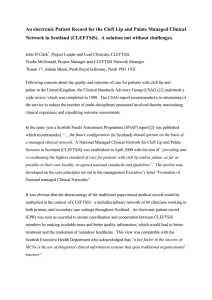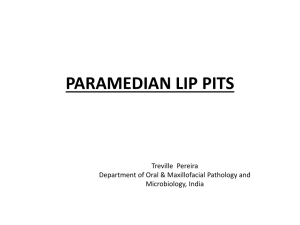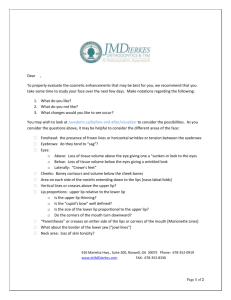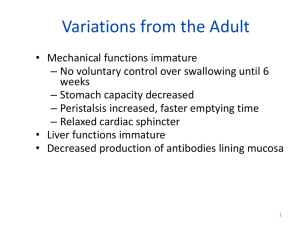developmental anamolies jaw n lip
advertisement
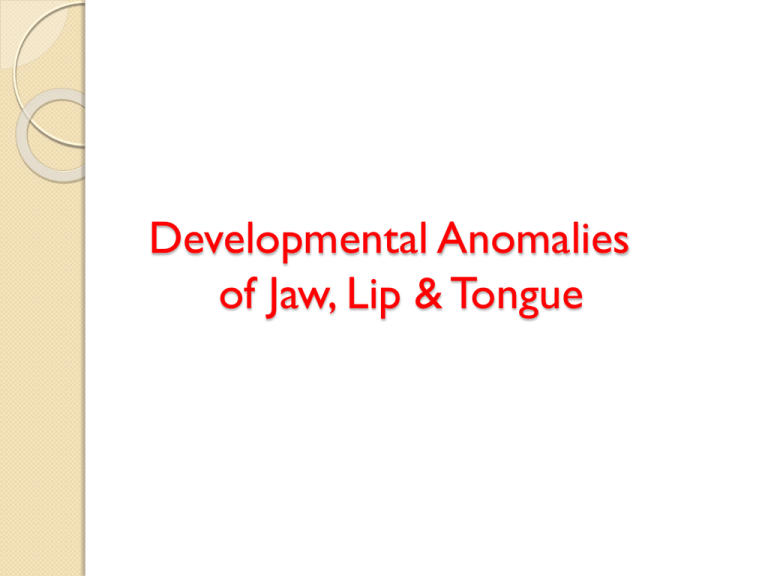
Developmental Anomalies of Jaw, Lip & Tongue Introduction Malformation or defects resulting from disturbance of growth & development are known as Developmental Anomalies Manifestation of defects are evident either at birth or some times after birth Types of Anomalies Hereditary / Familial developmental anomalies Acquired developmental anomalies Idiopathic developmental anomalies Agnathia Agnathia is a lethal anomaly characterized by hypoplasia or absence of the mandible or maxilla, it could be partial or complete. More commonly, only a portion of one jaw is missing. In the case of the maxilla, this may be one maxillary process or even the premaxilla. Partial absence of the mandible is more common than mandible . It is probably due to failure of migration of neural crest mesenchyme into the maxillary prominence at the fourth to fifth week of gestation (post-conception) The prognosis of this condition is very poor and is considered to be lethal. Micrognathia Micrognathia literally means a small jaw, and either the maxilla or the mandible may be affected. Many cases of micrognathia are not due to an abnormally small jaw in terms of absolute size, but rather due to an abnormal positioning or an abnormal relation of one jaw to the other or to the skull, which produces the illusion of micrognathia. Types True Congenital Acquired Apparent / Relative [Abnormal positioning/ relation of one jaw to the other or skull] Congenital Micrognathia Etiology unknown Associated with other congenital abnormalities like congenital heart disease and pierre robin syndrome Micrognathia of maxilla is due to a deficiency of the premaxillary area Micrognathia of mandible may be due to ◦ Small jaw ◦ Steep mandibular angle ◦ Agenesis of condyles Acquired Micrognathia Post natal in origin Causes ◦ Ankylosis of joint as result of trauma/infection Macrognathia Condition of abnormally large jaws ◦ Pagets disease of bone- Enlarged maxilla ◦ Acromegaly - Enlarged mandible ◦ Leontiasis ossea - Enlarged maxilla Cases of mandibular protrusion or prognathism, uncomplicated by any systemic condition, are a common clinical occurrence. Facial Hemihypertrophy a rare developmental anomaly characterized by enlargement which is confined to one side of the body, unilateral macroglossia and premature development and eruption as well as increased size of dentition. the permanent teeth on the affected side develop more rapidly and erupt before their counterparts on the uninvolved side. Coincident to this phenomenon is premature shedding of the deciduous teeth. The bone of the maxilla and mandible is also enlarged, being wider and thicker, sometimes with an altered trabecular pattern. FACIAL HEMIATROPHY Parry-Romberg syndrome slowly progressive atrophy of the soft tissues of essentially half the face. may be a form of localized scleroderma. The most common early sign is a painless cleft, the “coup de sabre”, near the midline of the face or forehead. The affected area extends progressively with the atrophy of the skin, subcutaneous tissue, the muscles, bones, cartilages, alveolar bone and soft palate on that side of the face. Dental abnormalities include incomplete root formation, delayed eruption, severe facial asymmetry resulting in facial deformation and difficulty with mastication. Eruption of teeth on the affected side may also be retarded. CLEFT LIP AND PALATE Cleft lip and palate are common congenital malformations. Heredity is one of the most important factors in the etiology of these malformations. However, environmental factors are important as well. Hence it is a disease of multifactorial inheritence. Clefts can be divided into ◦ Nonsyndromic - has no other physical or developmental anomalies ◦ Syndromic forms - that have additional birth defects like lip pits or other malformations Types ◦ Cleft lip ◦ Cleft lip and palate ◦ Cleft palate Cleft lip and palate can also be divided into ◦ Unilateral ◦ Bilateral Eating and drinking are difficult because of regurgitation of food and liquid through the nose. The speech problem is also serious and tends to increase the mental trauma suffered by the patient. Surgical correction has a good prognosis Developmental Disturbances of Lip Cleft lip Congenital lip pits Double lip Chelitis glandularis Chelitis Granulomatosa Peutz Jeghers syndrome CONGENITAL LIP PITS & COMMISSURAL PITS lip pits are malformations of the lips, often following a hereditary pattern Pits may result from notching of the lip at an early stage of development, with fixation of the tissue at the base of the notch Commissural pits may represent defective development of embryonic fissure. The lip pit or fistula is a unilateral or bilateral depression or pit, usually does not have any symptom but sometimes minor salivary glands may open into the pits causing oozing out of saliva. Van der Woude syndrome - cleft lip or cleft palate and distinctive pits of the lower lips Double Lip – is a rare anomaly characterized by an extra fold of tissue on the mucosal side of lip. Associated with Ascher syndrome – ◦ Double lip ◦ Blepharochalasis ◦ Non toxic thyroid enlargement Cheilitis Glandularis - inflammatory disorder of the lip, progressive enlargement and eversion of the lower labial mucosa. Potential predisposing factor for the development of actinic cheilitis and squamous cell carcinoma. Types – Simple type Superficial suppurative type (also referred to as baelz disease) Deep suppurative type CHEILITIS GRANULOMATOSA Melkersson-Rosenthal Syndrome chronic swelling of the lip due to granulomatous inflammation nontender swelling and enlargement of one or both lips. The first episode of edema typically subsides completely in hours or days. After recurrent attacks, swelling may persist and slowly increase in degree, eventually becoming permanent. Melkersson-Rosenthal syndrome is the term used when this occurs with facial palsy and fissured tongue Peutz-Jeghers Syndrome Hereditary intestinal polyposis syndrome Characterized by intestinal hamartomatous polyps with peri oral pigmentation. repeated bouts of abdominal pain in patients younger than 25 years, unexplained intestinal bleeding in a young patient 15 times increased risk of developing cancer exists in this syndrome over that of the general population; cancer primarily is of the GI tract. Developmental Disturbances of Oral Mucosa Fordyce’s granules - This is not a disease heterotopic collections of sebaceous glands at various sites in the oral cavity. Fordyce’s granules appear as small yellow spots, either discretely separated or forming relatively large plaques, often projecting slightly above the surface of the tissue DEVELOPMENTAL DISTURBANCES OF THE GINGIVA Fibromatosis gingivae Retrocuspid papilla
